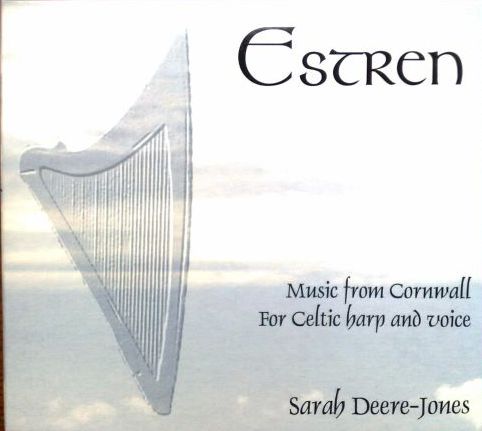 |
 |
'Stranger' from the Cornish language, - a musical tapestry of the most beautiful traditional songs and tunes from Cornwall, capturing the spirit of this ancient land with original compositions, and live recordings of some of Cornwalls' famous traditions, with Celtic harp and voice, performed and arranged by Sarah Deere-Jones.
This CD is available from our on-line shop page!
1) Estren/Pencarrow
Estren is a song collected from Mary Treese in Menhenoit in 1891, it is taken from the book 'Folk Songs of the West Country' By Sabine Baring-Gould, it is also known as the 'Emigrant's Song', it has four verses but I have used just the first verse. Pencarrow is the name of a stately home near Bodmin, and it is another tune collected by Baring Gould.
2) Sweet Nightingale/Porthlystry
Sweet Nightingale is a popular song heard in pubs across England but originally collected from Cornish miners in 1854 (again in SB-G collection) it isusually sing in a faster jolly style but I have tried to bring out the more sinister side of this song about seduction. Porthlystry (the old name for Newquay harbour) is a fast instrumental tune and was collected in the 1930s by AK Hamilton in 'Cornwall and its people'.
3) Padstow May Day/New Christmas Carol/Zeak Waltz
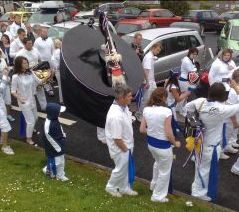 |
This track starts with some Aeolian harp music where the wind plays through the strings of a harp completely unaided, and was recorded on the North Cornwall coast to set a timeless introducton to the next field recording - taken of the Blue ribbon 'Oss as it processed through the streets on May Day morning. The Padstow May Day celebrations are one of the finest genuine folk traditions in the whole of the UK, two 'osses process through the streets to the music of this wonderful song, and this has been going on every year since at least the beginning of the 19th century and some say since the middle ages. The whole town is alive with excitement and celebration, and it is an occassion not to be missed, I am grateful to the Blue Ribbon 'Oss for its permission to use this recording! Two traditional tunes 'New Christmas Carol' and 'Zeak 'Waltz' (which must be a Cornish joke since it is nothing like a Waltz!) are merged into the Padstow celebrations in the whole track. |
4) So Deep in Love
Another song from the Baring-Gould collection, this one is found in various forms across England but this Cornish version was collected in St Enoder from 'a very old man' and has a particularly beautiful tune.
5) Dozmary/Rough Tor Reel/Logan Stone
Three instrumental pieces that I wrote for lever harp inspired by the landscape of Bodmin Moor, the bleak high wilderness in the centre of Cornwall of high rough moorland scattered with stone circles and strange 'Tors' - towers of exposed rock at the highest points. Dozmary is a large Pool reputed to have connections with the legend of King Arthur, Rough Tor (pronounced Row Tor) is one of the highest points which is so high it is visable from our home at Trehawsa many miles away, and a 'Logan stone' is one of the large slabs of granite found on both Bodmin and Dartmoor which rock mysteriously despite their huge size and weight.
6) Cradle Song
The chorus of this song is traditional and was collected at Torpoint and published in 1927 and appears in 'Canow Kernow' - since only the chorus remains, I have written verses inbetween to form it into a complete song.
7) Helston Flora Dance/Fer Lyskerrys
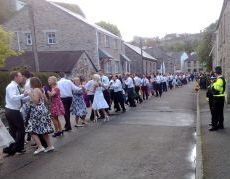 |
The beginning of this track is a field recording taken from the famous 'Flora' or 'Furry' Dance of Helston which takes place every year in May. This is a great celebration in the town and Cornish people come from all over th world to celebrate it. The dancing in the streets starts at 8am and carries on all day, again it is an ancient tradition and takes over the whole town. The famous music is played by the Helston Town Band and we are grateful to them for permission to use this recording. Fer Lyskerrys is an instrumental tune also known as 'Liskeard fair' and is another tune collected by Baring-Gould in 1891. |
8) The Penlee Lament
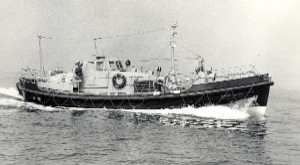 |
On 19th December 1981 eight lifeboatmen from the tiny village of Mousehole were lost on the Soloman brown (left) trying to rescue a stricken cargo ship the 'Union Star'. This worst disaster in the RNLI's recent history shocked the whole nation and as a young student at the time I never forgot it. Right is the Tintagel male Voice choir who join me singing the hymn 'Eternal father' which fits with my lament written as a tribute to these brave men who gave their lives to help others. | 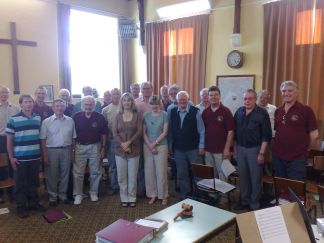 |
9) I Love my Love
Another tune found across England, but this version which appears in 'Canow Kernow' was collected in Helston at the turn of the century.
10) An Awhesyth/Hal-an-Tow
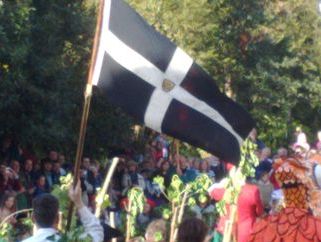 |
Another Aeolian (wind-blown) harp recording starts this track and leads into An Awhesyth, 'The Lark' - it is the tune from the Cornish version of the song 'the lark in the morn' and again is from the Baring-Gould collection, it is a pretty tune which here stands as an instrumental piece for harp and guitar. It leads into a field recording of the famous Hal-an-Tow tradition (left), again performed early in the morning in helston in May, it is an ancient mummers play performed to this song in the streets. |
11) Dons Pluvak/The three Hares/Syans den Bal
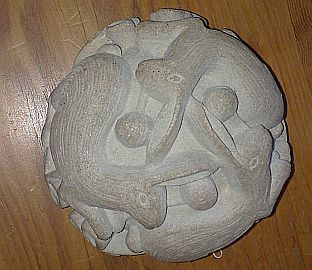 |
Dons Pluvak is an instrumental tune also known as 'Joan Sanderson' and the 'cushion dance' and also appears in Playford, the 'Three Hares' is an original tune I wrote for harp inspired by this symbol (left) found in churches in the South West and also known as a 'Tinners' Rabbit' it is a symbol found in places as far apart as China, caves in Southern France and churches in Cornwall. No-one knows the significance of the image or why it is called a Tinners' Rabbit, but it is a part of the extensive folk lore surrounding this fascinating creature. Syans den Bal is a traditional instrumental piece also known as the 'Miners fancy'. |
12/By a Woodland Stream
This piece is a virtuoso classical style piece I wrote for lever harp, in the style of Marcel Tournier, the great french 20th century composer for pedal harp. It is inspired by the small woodland stream that runs through the woods here at Trehawsa and which can be heard at the end of the track. It is dedicated ot my teacher the Russian harpist Renata Scheffel-Stein, who was for many years professor of harp at the Royal Academy of Music and principle harpist of the London Symphony Orchestra. The sheet music for this piece is available for downloading from the CornwallHarp Centre shop page and a video clip of Sarah playing it is also linked to the same page from You Tube.
This CD is available from the Cornwall Harp Centre on-line Shop page.
--------------------------------------------------------------------------------------------------------------------------------------------------------------------------------------
Soirbheas - CD
Music for Celtic and Aeolian (wind blown) harps
CD
of the year 2006 'Natalie Wheen Show' Classic FM
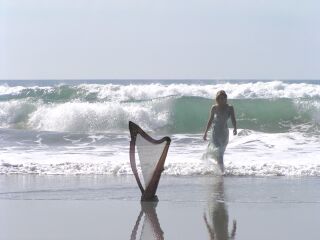
"An inventive, intuitive player....there is a timeless, spiritual beauty embedded in each of the five themes" Musician Magazine
"Quite beautiful" BBC Radio Wales (Celtic Heartbeat)
"Absolutely Magnificent" John Shaw - BBC Radio Trent.
"Amazing, experimental and traditional at the same time!" Stefano Pogelli - Radio RAI - Italy.
listen to St Govans Bell sample here (260Kb)
listen to Aeolian & Celtic Harp sample here (230kb)
To buy cd online with card click here
Soirbheas, pronounced 'surravis' is a Gaelic word meaning 'Fairwind', 'gentleness' and 'prosperity'
The magical and mysterious sound of the Aeolian or wind blown harp has fascinated people for thousands of years. This CD is a rare blend of Celtic harp music and Aeolian sounds, recorded at various locations throughout Celtic Britain and Ireland, weaving together the sounds of the instruments as well as the spirit of place and time, along with traditional music, improvisations and the sounds of nature.
 |
The CD contains the unique track 5 - 'Whispers' - a musical reflection on the diverse powers of the wind, with Aeolian harp sounds, the hypnotic beat of a wind turbine and a specially written piece for Celtic harp. Sample of 'Whispers' here (210Kb) |
When the wind blows through the strings of a harp, a unique and magical sound is produced. In times past it accounts for the harps status as a magical and mysterious musical instrument even with paranormal powers, Indeed, St Dunstan, once the Archbishop of Canterbury was accused of sorcery because his harp was said to be able to play by itself! In myths and legends there are various references to harps 'speaking' and producing music unaided by human hands. Nowadays Aeolian harps are specially made instruments, manufactured to hang up outside, stand on tripods or fit on window ledges, and many people have experimented with them with great results. Sarah Deere-Jones however, uses conventionally made Celtic harps, which have far more strings on them and therefore much greater versatility. Her knowledge and experience as a harpist and musician, enables her to tune the 'aeolian' harps to special modes and chords, which when given to the wind, produce even more spectacular sounds. It also means she can blend the 'aeolian' sounds with 'human' music within the same keys and pitches, creating perfect compatability.
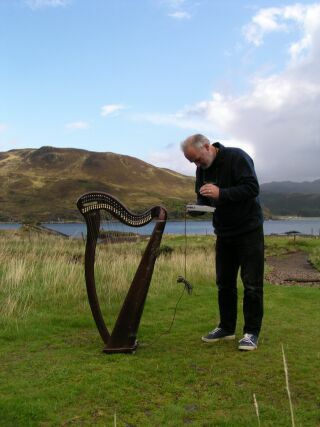 |
Sarah and her husband
Phil have been recording Aeolian harp sounds for 20 years
from the southernmost parts of Brittany to the outer
Hebrides in Scotland. There are many technical challenges
involved and only in recent years has the technology to
create CD quality field recordings of this type been made
affordable and truly portable. The wind vibrates the
strings and mysteriously picks out certain notes or
harmonics, sometimes bringing them to spectacular
climaxes with steady throbbing and humming of one
particular note. At other times, the wind produces gentle
wispy glissandos up and down the harp. No two aeolian
recordings are ever the same, and different locations can
produce vastly different effects. Sarah believes the
'spirit of place and time ' can be a reason for this, as
well as more obvious explanations such as weather
conditions! Different places have different atmospheres,
in the same way that people describe a house as being
'welcoming' or 'friendly' many locations have their own
atmosphere and Sarah believes its possible the aeolian
harp may be absorbing this in some way. She has for
example had experiences of aeolian harps producing
violent 'banshee' like wailing, and discovering
afterwards that the site where the recording was made had
a violent or tragic history. Whatever the true reasons
are, no-one can listen to the aeolian harp without being
struck by the mysterious and other-worldy nature of the
sound. Phil is pictured here checking the levels of a recording made on the west coast of Scotland, due to modern day sound interferance, eight out of ten recordings are eventually rejected! |
Sarah and Phil travelled to the Celtic areas of Britain to make their recordings of Aeolian harp music, because in most of these areas the harp has an extensive history and tradition, and also because they are simply beautiful and inspiring locations. To emphasise the concept of 'spirit of place' Sarah chose traditional music from the areas where the recordings were made to blend in with the aeolian sounds.
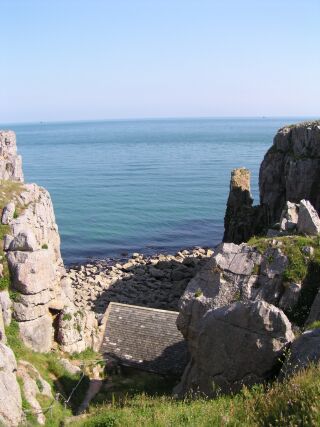 |
Track 1- St Govan's Bell
(Wales) 13 mins St Govan's head in Pembrokeshire Wales, is a spectacular location. St Govan is said to have created a hermitage here in the 6th century and the remains of the chapel and holy well are still there. Legend has it that the bell from the chapel was stolen by pirates and that angels brought it back to St Govan encased in stone. The Aeolian recording was made right at the bottom of the cliffs in June 2005 on a wonderfully calm day, indeed you can hear choughs and gulls on the cliffs behind during the Celtic harp improvisation called 'Sea Spell'. This goes into the sound of a chiming bell and Sarahs jig for harp 'St Govan's Bell'. This in turn leads to the sound of rolling waves and a beautiful traditional welsh song Ar Lan Y Mor, 'On the Sea Shore' |
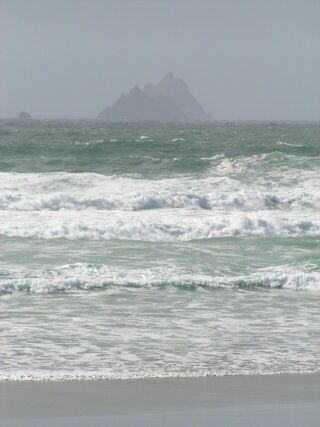 |
Track 2- Mists of the
Skelligs (Ireland) 14 mins Skellig Michael is a dramatic steep sided island off the west coast of Ireland and was an ancient monastic site. Aeolian sounds recorded on the nearby shore at Kilrelig with a brisk wind blowing directly from the Skelligs in September 2005 lead into the improvisation on wire-strung harp 'lost souls' which focuses on the sad history of the area with the remains of a famine village as well as a 2nd world war memorial dedicated to 11 lost American airmen.' The Hurlers' is an ancient irish harp tune and 'Bunavalla' a jig by Sarah, and they lead into the lovely 'Derreen Day' a traditional Irish Lullaby. |
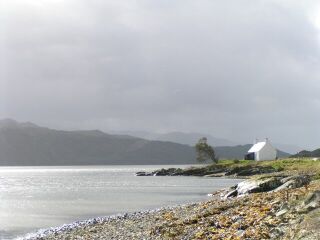 |
Track 3- Hebridean Dreams
(Scotland) 14 mins Recorded in September 2004 the Aeolian sounds introduce the traditional reel 'sound of sleat' which is the name of the channel of water overlooked from the village of Kylerhea on the south East corner of the Isle of Skye. The piece for harp and Scottish smallpipes 'Tigh a Rudha' is dedicated to a tiny croft on the edge of the promontory in the village and leads into 'the Sheilings' a reel for harp also by Sarah. Finally the track ends with the beautiful Uist cradle song which is entwined with a hebridean psalm tune called the 'Bays of Harris'.. |
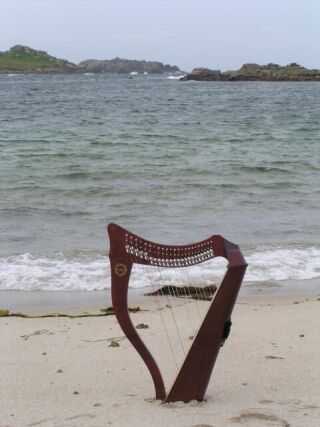 |
Track 4- Kernow Summer
Storm (Cornwall) 12 mins Being at the far south west of the UK Cornwall is lashed by the storms coming from the Atlantic and even in the summer these can be dramatic! A rumble of thunder with aeolian sounds recorded in August 2005 introduces the majestic 'Padstow May Day song' on harp before the thundery rain leads into the traditional dance tune 'Porthlystry'. Finally Sarahs popular 'Cornish Lullaby' ends the track. |
 |
Track 5- Whispers (wind
turbine and celtic harp) 7 mins The hypnotic beat of a wind turbine combined wirth the wind generated aeolian harp sounds recorded in the same summer breeze in 2005 inspired the initial improvisation and the piece 'whispers' a musical reflection on the diverse power of the wind, for turbine and harp! |
Sarah Deere-Jones - Celtic harp/wire-strung harp, and voice
Phil Williams - Uilleann and Scottish smallpipes, cittern and guitar.
Thanks must go to my husband Phil Williams, who has his own life to lead but nevertheless spent hours in patient recording in the wind and rain spanning 20 years, and yet more hours editing at the computer, not to mention his boundless enthusiasm, musical accompaniament, ideas and encouragement all the way! Tim Deere-Jones for location help in Wales, Merv Collins Bell-ringer, Margot and Alasdair MacInnes in Kylerhea for teaching us the 'Bays of Harris'. Robert Archer and Robert Falkenburg for their inspiring fascination and experiments with Aeolian harps, and my musical hero ALAN STIVELL, for years of wonderful music and unwitting guidance towards my own musical aspirations.
To Order Soirbheas CD online click here
Please e mail info (at) cornwallharpcentre.co.uk for details of ordering